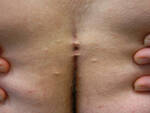
16 Nov Reduced Recurrence of Pilonidal Cysts with Addition of Laser Hair Removal
MedicalResearch.com Interview with:

Dr. Minneci
Peter C. Minneci, MD
Chair of Surgery at Nemours Children’s Health
Delaware Valley
MedicalResearch.com: What is the background for this study? Would you briefly explain the symptoms/course of pilonidal disease?
Response: Pilonidal disease is relatively common and affects up to 1% of the population starting in adolescence and up until young adulthood. Pilonidal disease occurs when cysts or sinuses form between the buttocks. It is believed to be an inflammatory reaction to hair or debris that gets caught in the crease of the buttocks. Risk factors for the condition include a sedentary lifestyle, hygiene and obesity.

Pilonidal Cyst
DermNet Image
Pilonidal disease can be intermittent or chronic and recurs about 33% of the time, with 80% of recurrences taking place within a year of initial treatment. These recurrences contribute to a high degree of psychosocial stress in patients, who often miss school or sports and may avoid social activities. Pilonidal cysts may become infected, in which case patients must take antibiotics or undergo surgery.
Standard treatment for pilonidal disease involves removal of hair with razors or creams, as well as recommendations such as keeping the area clean. In recent years, some practitioners have begun using laser epilation as an additional strategy to prevent recurrence by providing more durable hair removal. However, it’s important to point out that this is not covered by insurance. In addition, as a provider, I have found that my patients that do have the means to pay often don’t comply with the number of sessions needed to fully remove the hair due to many different factors including pain and discomfort during the procedure.
MedicalResearch.com: Would you also describe the laser procedure?
Response: In the medical setting, the patient would come in like they would for any other appointment. We would shave the area, a small rectangle centered around the gluteal cleft, and apply a numbing cream. The numbing cream typically takes 40minutes to take effect. The laser used is chosen based on your skin color. For your comfort, each laser has a cold tip to provide additional analgesia. The tips are 1-1 ½ cm, and sequential pulses are performed (75-250 times) to the area to destroy the hair follicles. The patient may feel a slight stinging sensation with each pulse.
There is no downtime after the procedure. Any pain that was felt during the procedure immediately ends after completion of the laser treatment. The patient can resume all regular activities.
It typically takes 5 treatments, spaced one month apart for effective office-based hair removal.
MedicalResearch.com: What are the main findings?
Response: Currently, standard treatments being offered or recommended to patients with pilonidal disease is hair removal, using razors or creams, as well as keeping the area clean. Knowing that patient compliance with this type of regiment is often difficult to achieve, this study sought to use laser epilation, more commonly known as laser hair removal, as an adjunct treatment method to garner a significant long-term reduction in hair growth.
The study compared using laser hair removal in addition to the current standard of care. Half of the participants were assigned to receive laser epilation plus standard treatment, and half were assigned to receive standard treatment alone. After one year, 10.4% of the patients who had received laser epilation plus standard treatment had experienced a recurrence, compared with 33.6% of patients in the group who had received standard treatment alone. There were no significant differences between the two groups in terms of complications, disability days, health care satisfaction or perceived stigma.
These results provide further evidence that laser epilation is safe, well-tolerated and should be available as an initial treatment option or adjunct treatment modality for all eligible patients.
MedicalResearch.com: Is there anything else you would like to add?
Response: Unfortunately, most insurers do not cover laser epilation, and a course of treatment could cost $800 to $1,500. In teenage patients dealing with a sensitive area of the body, there is some discomfort and embarrassment. Receiving this treatment in a medical setting, where professionals are sensitive to their experience, would be beneficial. If this procedure is covered by insurance, it will become widely available, allowing for more equitable treatment of all patients with pilonidal disease.
Disclosures: There are no disclosures to report. The study was funded by a Patient Centered Outcomes Research Institute (PCORI) award.
Citation:
Minneci PC, Gil LA, Cooper JN, et al. Laser Epilation as an Adjunct to Standard Care in Reducing Pilonidal Disease Recurrence in Adolescents and Young Adults: A Randomized Clinical Trial. JAMA Surg. Published online November 08, 2023. doi:10.1001/jamasurg.2023.5526doi:10.1001/jamasurg.2023.5526
The information on MedicalResearch.com is provided for educational purposes only, and is in no way intended to diagnose, cure, or treat any medical or other condition.
Some links may be sponsored. Products are not endorsed.
Always seek the advice of your physician or other qualified health and ask your doctor any questions you may have regarding a medical condition. In addition to all other limitations and disclaimers in this agreement, service provider and its third party providers disclaim any liability or loss in connection with the content provided on this website.
Last Updated on November 16, 2023 by Marie Benz
